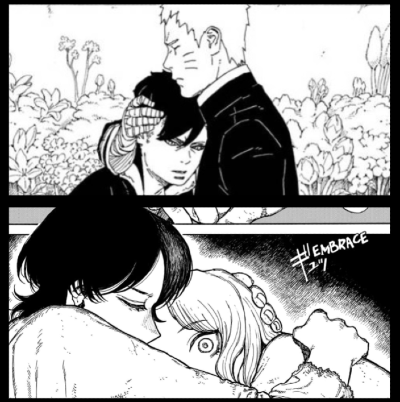The Power of Pacing: Boruto and Centuria

For non-Centuria readers, I've tried to ensure this post stays low-spoiler for both series, beyond discussion of the initial plot set up.
In April of 2024, the Shinju invaded Konoha, Boruto kicked Kawaki's ass, and Kurama revealed himself to exist inside of Himawari in Boruto: Two Blue Vortex. (TBV) That same month, Centuria debuted and, in its first issue, Julian found and lost pure love, survived an insurance fraud scheme that claimed 100 lives, was blessed by a sea monster, witnessed an unorthodox cesarean section, and became a dad. In the past year, TBV completed its first arc and began its second while Centuria went through four arcs, two time skips, two birthday parties interrupted by battles, three separate abodes, and left a pile of bodies in its wake.
While Boruto has gone through 12 chapters in the past year due to its monthly release schedule, Centuria has put out 47. While it'd be easy to say that this means Centuria has put out four times as much content in that time (or that it's comparable to what happens in chapter one of Boruto in which a self-proclaimed brat is feuding with his father's career and chapter 47, in which Kawaki loses his karma after Kashin Koji defeats Jigen (only to free Isshiki), this wouldn't be a fair comparison, either. Per chapter, Boruto, on average, has twice the number of pages that Centuria does, so a more accurate comparison of the span of the two series would be the ground covered in Boruto between chapter one of TBV and chapter 20.
However we define the room which each manga has allocated to tell its story (release span, chapters, or the amount of pages), it's clear that Centuria takes a fundamentally different approach to pacing than Boruto, moving the story along at a brisk pace. However, what's interesting within that brisk pace is that Centuria still creates enough space to build up its characters and form rich relationships between them.
Centuria uses many tools in the mangaka toolbox to build up characters and the dynamics between them: characters engage both in internal dialogue and conversations between one another, telling you what they're thinking and how they feel. It's also not afraid to embrace a quiet chapter or a moment of domestic bliss to build up tension and stakes, telling readers how much the characters would lose if they lose each other. It's also not afraid to lean heavily into flashbacks to give characters emotional depth and context.
This differs from Boruto's approach in that characters aren't as densely populated in the story, forcing them together, and forcing them to talk about things beyond the plot they're facing directly. Especially since the beginning of TBV, the story has rarely given us moments in which the characters interact with each other rather than reacting to what's going on around them. Due to that, relationships themselves also develop slowly or are poorly defined.
This is not to discount the benefits of Boruto's pacing, though. What the series delivers well on is suspense and expectation, creating speculation and theorizing. The things that remain unsaid in the series are what haunts us: how does Boruto feel about Sarada? Exactly how much does Boruto know about the future? What are Kawaki's true feelings toward anyone? How is Sarada processing her father's tree-dom?
The Boruto series itself is written to feed obsession, the gaps in the story fueling our desire to know what's next. We can see that the characters themselves know so much more than is said on the page, the reliance on mysterious eyes and non-verbal cues telling us something more is going on without telling us exactly what that something is. Since the Kawaki Arc, flashbacks haven't been deployed to tell us who characters are and their emotional baggage. Rather, flashbacks tell us what we missed, lifting back the curtain on pieces of the plot that are strategically revealed.
That said, the storytelling stakes of the two series aren't that dissimilar, each one relying on premonition to foretell of a ruinous future in which a key player in the story is responsible for mass destruction. And the main characters, Julian and Boruto respectively, are both protecting the person who might be responsible for a tragedy of epic proportions, turning on the values that they hold dear.
As a reader, I cannot forget about Boruto release day, each chapter bringing me closer to answers I so desperately crave. And while I do read Centuria on a weekly basis, I don't need to open a new chapter as soon as it releases on a Sunday. I don't experience that same giddy nervousness, that drive to know what's going to happen next. I want to read it, but I don't obsess over it.
But I think reading Centuria is instructive for Boruto fans because it helps understand the differences in pacing of series, and what different readers might mean by pacing when they use that term. Boruto's plot does move fast, but it doesn't embrace quiet moments for development in the same way, the story itself covering only a few weeks in the past 20 chapters. Centuria also moves fast and is chock full of epic fights, but utilizes time differently, both the span of time in which the story takes place and what aspects of story development its exploring in each chapter.
I don't think there's a right way to tell a story, and each writer, each mangaka, needs to follow the path that they think will provide the impact they're aiming to deliver. Boruto and Centuria are two fast-moving series, utilizing divergent pacing techniques to develop their stories. I'm enjoying reading both at the same time because, at least from a storytelling perspective, seeing the contrasts between how each series is handled feels more instructive than reading either alone.
